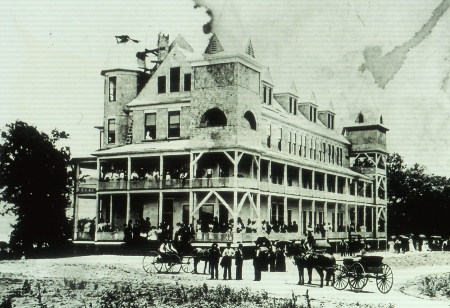The early 1890s brought a flurry of town development in Southeast Harris County, as well as in neighboring areas of Galveston and Brazoria Counties. The people behind the enterprises followed in the footsteps of the Allen Brothers, developers of the county's most successful settlement, by platting lots and promoting the area as a delightful climate both for enjoyable living and for making money. In the span of mere months, a bevy of developers began marketing and selling lots that today form the centers of Pasadena, Pearland, Dickinson and Deer Park, and also La Porte.
Prospective buyers were brought in by trains and boats, coming from across the Midwest to get a piece of semi-tropical paradise which they could fill with fruit orchards. The early 1890s, however, proved to be a less than perfect time for these promoters. In 1893, the United States entered the worst economic depression it had suffered up to that time, spurred by over-development in railroads and silver mining and the subsequent collapse of the related speculation bubbles. Unemployment jumped from around 3% in 1892 to over 11% by 1893 and 1894, a number that would hold for five more years. For land promoters who were already under-capitalized and over extended, it often meant bankruptcy.
It didn't help the sales pitch when just a year and a half after the financial trouble started, the area along Galveston Bay experienced the coldest weather it had ever known. On February 7, 1895 the temperature on the island dropped to a record low of 15 degrees. A week later, another front rolled in. Clouds darkened the sky, and heavy wet flakes began to fall. To this day, the snow fall of February 14 and 15 dwarfs any other number the area has ever experienced. Galveston measured over 15 inches while Houston reported an incredible 22. Ducks, innumerable along the shore, froze to the water and darkened the bay. The citrus trees central to the land offering were also goners. Imagine that scene greeting the potential new residents who got off the train that Valentine's Day. Not surprisingly, many of them got right back aboard and headed north.
The backers of La Porte, though, had a stroke of luck, even though the development company itself wouldn't retain ownership long enough to see it pay off. As they were establishing the town site, they had set aside 22 acres of bay front for a park. Known as the grove, it centered around a large group of shade trees in an area otherwise dominated by coastal prairie. It was a perfect place to fish, swim, hunt and picnic. On the Fourth of July 1893, the new Sylvan Grove was inaugurated with music, foot races, ponies and balloons.
| The difficulty in capitalizing on the beautiful spot arose in the travails of getting there. The dirt roads were no better than glorified paths prone to becoming quagmires in rain. There were boats from Houston and Harrisburg, but the channel was still being dredged. Backers had started a railroad, the La Porte, Houston and Northern, but it had largely failed. By early 1895, however, the rail assets had been consolidated with lines known as the Northern Galveston, Houston and Kansas City Railroad and the Houston Belt and Magnolia Park Railroad. The new entity was called the Galveston, La Porte and Houston. On April 7 of that year, newspapers announced that the line was now completed between the latter two communities, even though the full story was that the La Porte end stopped a ways short of the water, requiring a horse drawn cab to truly complete the trip. By August 7, 1895 the railroad was promoting "Moonlight on the Bay", promising that La Porte was becoming the "most delightful and inviting summer resort in Texas". Friday and Saturday nights were the time to head to the water for an evening's delight. For a mere 60 cents round trip, the train left downtown Houston at 6:00 PM. After a few hours by the bay, it pulled out of the La Porte station at 10:30. Management assured passengers that the Houston streetcar company would be running until at least midnight, allowing everyone to easily reach their homes on the electric cars. |  |
Facilities had also been upgraded by that August. The Houston Post reported that the "fine large pagoda is now completed and ready for use. The beautiful sylvan grove has been provided with seats, tables, lunch stands and dancing pavilion. There is no lack of amusements for the enjoyment of young pleasure seekers..." For those who wished to stay overnight, La Porte boasted plenty of hotel rooms at the Sylvan, Artesian, Crescent and Ballantine.
Eventually La Porte and the rest of the new communities would start to thrive for the reasons their promoters initially imagined. Though citrus trees proved a finicky match for the Harris County climate, figs prospered. Following the devastating hurricane of 1900, the Red Cross brought over a million strawberry plants to Pasadena, providing another cash crop to the area for decades.
As for Sylvan Beach, it would grow into one of the nation's top waterside resorts in the 1920s and 30s. A succession of park owners brought updates and improvements. The open-air dance pavilion and band stand hosted marquee names like Benny Goodman and Rudy Vallee, and with the new century, the Moonlight Excursions to Sylvan Beach that started in August 1895 would become a staple for those fun seeking citizens of Houston and Harris County.
By Mike Vance